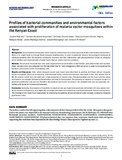Profiles of bacterial communities and environmental factors associated with proliferation of malaria vector mosquitoes within the Kenyan Coast
Date
2023-08-17Author
Mutinda, Josphat
Mwamburi, Samuel Mwakisha
Oduor, Kennedy Omondi
Omolo, Maurice Vincent
Ntabo, Regina Mongina
Gathiru, James Muhunyu
Mwangangi, Joseph
Nonoh, James O. M.
Metadata
Show full item recordAbstract
Background. Since Anopheles mosquitoes which transmit and maintain the malaria parasite breed in the outdoor environment, there is an urgent need to manage these mosquito breeding sites. In order to elaborate more on the ecological landscape of mosquito breeding sites, the bacterial community structure and their interactions with physicochemical factors in mosquito larval habitats was characterised in Kwale County (Kenya), where malaria is endemic.
Methods. The physical characteristics and water physicochemical parameters of the habitats were determined and recorded. Water samples were also collected from the identified sites for total metagenomic DNA extraction in order to characterise the bacterial communities within the breeding sites.
Results and Discussion. Sites where mosquito larvae were found were described as positive and those without mosquito larvae as negative. Electrical conductivity, total dissolved solids, salinity and ammonia were lower in the rainy season than in the dry season, which also coincided with a high proportion of positive sites. Pseudomonadota was the most common phyla recovered in all samples followed by Bacteroidota and then Actinomycetota. The presence or absence of mosquito larvae in a potential proliferation site was not related to the bacterial community structure in the sampled sites, but was positively correlated with bacterial richness and evenness.
Conclusion. Generally, the presence of Anopheles mosquito larvae was found to be positively correlated with rainy season, bacterial richness and evenness, and negatively correlated with electrical conductivity, total dissolved solids, salinity and ammonia. The findings of this study have implications for predicting the potential of environmental water samples to become mosquito proliferation sites.
URI
https://doi.org/10.1099/acmi.0.000606.v4https://www.microbiologyresearch.org/content/journal/acmi/10.1099/acmi.0.000606.v4?crawler=true
http://ir-library.mmust.ac.ke:8080/xmlui/handle/123456789/2423
Collections
- Gold Collection [1026]

